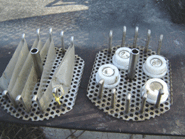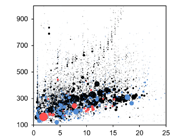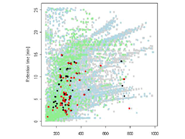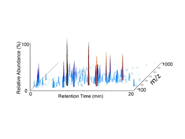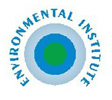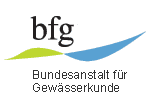You are here
Glossary of Terms
This Glossary of terms contains the terminology frequently used in the work of the NORMAN network.
A B C D E F I L M N O P Q R S T U V W
| Term / NORMAN Definition | Source/field | |
| A | Top | |
|
Accepted reference value A value that serves as an agreed-upon reference for comparison, and which is derived as:
when a), b) and c) are not available, the expectation of the (measurable) quantity, i.e. the mean or the median of a specified population of measurements |
ISO 3534-1 | |
|
Accreditation (of laboratories) Procedure where an independant authority body acknowledges that an organisation or a person is competent to carry out specified tasks. Accreditation relies on criteria or procedures to assess the technical competencies. Accreditation acknowledges the conformity of the quality system as well as the competencies of the staff. |
COFRAC (French committee of accreditation) | |
|
Accuracy The closeness of agreement between a test result and the accepted reference value. |
ISO 3534-1 | |
|
Adaptation Deliberate modification of a test method with the aim to extend its scope or applicability, e.g. to make it applicable for a new matrix or organism |
||
|
Analyte The substance subject to analysis |
Norman project | |
|
Analytical method Any fully documented and validated method describing procedures that enable the amount or concentration of a parameter to be determined to a stated uncertainty |
D. Westwood | |
|
Analytical run To be defined (sub project validation) |
||
|
Applicability To be defined (sub project validation) |
||
| B | Top | |
|
Bias The difference between the expectation of the test results and an accepted reference value. |
ISO 3534-1 | |
|
Biomarker A change in biological response, ranging from molecular through cellular and physiological responses to behavioural changes, which can be related to exposure to or toxic effects of environmental chemicals |
Peakall 1994 | |
|
Blank To be defined (sub project validation) |
||
| C | Top | |
|
Calibration Operation establishing the relation between quantity values provided by measurement standards and the corresponding indications of a measuring system, carried out under specified conditions and including evaluation of measurement uncertainty. |
VIM (2) | |
|
Calibration laboratory A laboratory producing standards of known composition and uncertainty which are then used by other laboratories for calibration purposes |
D. Westwood | |
|
Certification Third party, independent process confirming compliance to specified requirements |
D. Westwood | |
|
Certified Reference Material Reference material, accompanied by a certificate, one or more whose property values are certified by a procedure, which establishes its traceability to an accurate realisation of the unit in which the property values are expressed, and for which each certified value is accompanied by an uncertainty at a stated level of confidence |
ISO/IEC Guide 30 – 1992 | |
|
European Topic Centre Institutions/organisations contracted by the EEA to execute tasks identified in the multiannual work programme. They are designated by the management board after a competitive expertise/capacity selection process. Guiding principles for selection should be the cost-efficient use of existing and potential capacities in the member countries and avoidance of duplication of work and capacities. |
EEA (1) | |
|
Community Reference Laboratory (CRL) Community Reference Laboratories" (CRLs) with scientific and technical expertise within the areas of animal health, public health and zootechnics have been designated in different Community Decisions, Directives and Regulations. Within the framework of Council Decision N° 90/424/EEC on expenditure in the veterinary field of 26 June 1990, these laboratories may receive a Community financial aid for fulfilling tasks and functions specified in legislation. |
Food area (6) | |
|
Comparability Property of measurement results enabling them to be compared because they are metrologically traceable to the same stated metrological reference |
VIM (2) | |
|
Contact Point Expert from leading institutes / organisations / research centres to be identified in the different European countries in order to collaborate with the NORMAN network for:
|
NORMAN project | |
|
Contaminant Any physical, chemical, biological, or radiological substance or matter that has an adverse effect on air, water, or soil. |
EPA | |
|
Control Chart To be defined (sub project validation) |
||
|
Criteria General definition: a descriptive factor / a measure |
Literature | |
|
Criteria of accreditation Internationally recognised requirements as described in ISO 17025 |
D. Westwood | |
|
Criteria for Contact Points A Contact Point should meet the following criteria:
A Contact Point should be committed to carry out the following tasks:
|
Norman project | |
|
Criteria for analytical laboratory
|
Commission directive 2002/69/EC (food) | |
|
Criteria for expert laboratory
|
BRGM | |
|
Criteria for research laboratory
|
BRGM / UKEA | |
|
Criteria for national reference laboratory Competencies:
Missions:
|
BRGM (Norman project) | |
| D | Top | |
|
Development In this guide, development is used in the meaning of extending the applicability of a method, e.g. to a new matrix, compound or organism. |
||
| E | Top | |
|
A substance currently not included in routine environmental monitoring programmes and which may be candidate for future legislation due to its adverse effects and / or persistency. |
Norman project | |
|
A substance that has been detected in the environment, but which is currently not included in routine monitoring programmes and whose fate, behaviour and (eco)toxicological effects are not well understood |
Norman project | |
|
Expert laboratory Laboratory judged by one’s peers and recognised as expert on a specific area, field or theme. Besides activities in the research area, it may be involved in activities related to policy development and / or implementation, standardisation, certification, accreditation. |
BRGM | |
| F | Top | |
|
Fitness for Purpose Degree to which data produced by a measurement process enables a user to make technically and administratively correct decisions for a stated purpose |
IUPAC Orange Book | |
|
National Focal Point National Focal Points (NFPs) are appointed and funded by member countries and are in charge of national co-operation with the EEA and national co-ordination of activities related to the EEA work programme. |
EEA (1) | |
| I | Top | |
|
Indicator (Environmental Indicator) A concise measure of cumulative effects and ecosystem vulnerability. |
EPA | |
|
Interference To be defined (sub project validation) |
||
|
Intermediate precision (within-lab reproducibility) Precision under conditions where independent test results are obtained with the same method on identical test items in the same laboratory by different operators using different equipment on different days. |
SWIFT VG (5) | |
|
Internal Standard To be defined (sub project validation) |
||
| L | Top | |
|
LC 50/Lethal Concentration Median level concentration, a standard measure of toxicity. It tells how much of a substance is needed to kill half of a group of experimental organisms in a given time. (See: LD 50.) |
EPA | |
|
LD 50/ Lethal Dose The dose of a toxicant or microbe that will kill 50 percent of the test organisms within a designated period. The lower the LD 50, the more toxic the compound. |
EPA | |
|
Limit of Detection The lowest concentration of analyte in a sample that can be detected with stated level of confidence, but not necessarily quantitated under the stated conditions of the test. |
NATA Tech note #13 | |
|
Limit of Quantitation (or Limit of Quantification) The lowest concentration of an analyte that can be determined with acceptable precision under the stated conditions of the test |
NATA Tech note #13 | |
|
Linearity The ability of the response of the method (signal, colour density…) to obtain test results proportional to the concentration of analyte. |
AOAC-PVMC | |
|
Lower Limit Of Applicability The lowest concentrations for which a method has been validated with specified accuracy |
AMPS draft final report | |
| M | Top | |
|
Matrix To be defined (sub project validation) |
||
|
Matrix effect To be defined (sub project validation) |
||
|
Measurand Quantity intended to be measured |
VIM 2004 | |
|
Measurement Process of experimentally obtaining information about the magnitude of a quantity |
VIM 2004 | |
|
Measurement Uncertainty Parameter that characterises the dispersion of the quantity values that are being attributed to a measurand, based on the information used. |
VIM 2004 | |
|
Metadata Data about data, e.g. Date and location of sampling are metadata for concentration data measured at a given site |
EEA (1) | |
|
Method, Test method To be defined (sub project validation) |
||
|
Monitoring (under WFD) The three modes of monitoring specified in the WFD include
|
WFD | |
|
Monitoring (Bio-monitoring)
|
Metropolis (3) | |
|
Monitoring (Risk monitoring) Process of following up the decisions and actions within risk management in order to ascertain that risk containment or reduction with respect to a particular hazard is assured. |
EEA (1) | |
| N | Top | |
|
Negative Control To be defined (sub project validation) |
||
| O | Top | |
|
Optimisation Deliberate modification of a test method with the aim to improve its performance, e.g. with respect to lower limits of quantitation, smaller measurement uncertainty or better selectivity |
Norman project | |
|
Outlier A member of a set of values which is inconsistent with the other members of that set. |
ISO 5725-1 | |
| P | Top | |
|
Pollutant Generally, any substance introduced into the environment that adversely affects the usefulness of a resource or the health of humans, animals, or ecosystems. |
EPA | |
|
Positive Control To be defined (sub project validation) |
||
|
Precision The closeness of agreement between independent test results obtained under stipulated conditions. |
ISO 3534-1 | |
|
Proficiency Testing A periodic assessment of the performance of individual laboratories and groups of laboratories that is achieved by the distribution by an independent testing body of typical materials for unsupervised analysis by the participants |
IUPAC Orange Book | |
|
Primary procedure Measurement procedure used to realise the definition of a measurement unit and obtain the quantity value and measurement uncertainty of a primary measurement standard. |
VIM (2) | |
| Q | Top | |
|
Quality Assurance Planned activities designed to ensure that the quality control activities are being properly implemented. |
AOAC (4) | |
|
Quality control A planned system of activities designed to provide a quality product. |
AOAC (4) | |
|
Quantity Property of a phenomenon, body, or substance, to which a magnitude can be assigned |
VIM 2004 | |
|
Quantity values Magnitude of a quantity represented by a number and a reference |
VIM 2004 | |
| R | Top | |
|
Range The difference between the largest and the smallest observed value of a quantitative characteristic |
ISO 3534-1 | |
|
Recovery If a known amount of analyte is added to a test sample and the test sample is then analysed for that analyte by a particular method, the recovery is that fraction of the amount of analyte added which is found by the method |
SWIFT VG (5) | |
|
National Reference centre National reference centres (NRCs) are not mentioned in the regulation, but have been defined subsequently as a special set of main component elements . National reference centres are therefore also nationally funded institutions/organisations which may be nominated by member countries to play a role in technical co-ordination within their countries and cooperate with the European topic centre established to cover various topics. |
EEA (1) | |
|
National Reference laboratories Nationally-funded institutes/ organisations, designated by the competent authorities to offer technical and scientific support in specific fields. The designation and the organisation of their missions may vary from one country to another in the EU (certain countries have permanently designated one or more NRLs, other competent authorities have chosen to select NRLs from their current operating "contractors"). As a common denominator their role and tasks include:
|
INERIS / BRGM (Norman project) |
|
|
Reference Material Material or substance one or more of whose property values are sufficiently homogeneous and well established to be used for the calibration of an apparatus, the assessment of a measurement method, or for assigning values to materials |
ISO/IEC Guide 30 | |
|
Repeatability Precision under repeatability conditions, i.e. conditions where independent test results are obtained with the same method on identical test items in the same laboratory by the same operator using the same equipment within short intervals of time |
ISO 3534-1 | |
|
Research laboratory Laboratory judged by one’s peers and recognised as expert on a specific area, field or theme. |
BRGM | |
|
Reproducibility Precision under reproducibility conditions, i.e. conditions where test results are obtained with the same method on identical test items in different laboratories with different operators using different equipment. |
ISO 3534-1 | |
|
Residual Difference between the observed response and that predicted by a calibration function. |
SWIFT VG (5) | |
|
Robustness The robustness of an analytical procedure is a measure of its capacity to remain unaffected by small, but deliberate variations in method parameters and provides an indication of its reliability during normal usage |
ICH Q2A | |
|
Routine analysis laboratory "Any laboratory undertaking analysis of a parameter, whether as part of a legislative need or requirement, or not as the case may be, and where the result is generated using a fully validated and documented method with established performance characteristics such as precision and bias produced within that laboratory". |
D. Westwood | |
| S | Top | |
|
Sample The totality of a homogeneous analysis material having an identical composition or quality (similar to term batch) |
ISO CD 20612 | |
|
Sample — Field Sample For example, the bulk of water collected from the river |
SWIFT VG (5) | |
|
Sample — Laboratory Sample Primary sample material delivered to the laboratory |
SWIFT VG (5) | |
|
Sample — Subsample A defined portion of a sample obtained by suitable sample division and identical in terms of composition |
ISO CD 20612 | |
|
Sample — Test sample The aliquot of the laboratory sample taken for processing into a test portion |
SWIFT VG (5) | |
|
Sample — Test portion The portion of the laboratory sample taken for analysis or testing |
SWIFT VG (5) | |
|
Sample handling The manipulation to which samples are exposed during the measurement process, from the selection from the original material through to the disposal of all samples |
SWIFT VG (5) | |
|
Sample preparation The procedures followed to select the test portion from the sample (or sub-sample). These include in-laboratory processes such as: homogenisation, mixing, and filtering. It often includes chemical operations such as: extraction, separation, derivatisation, and concentration |
SWIFT VG (5) | |
|
Selectivity The ability of a method to determine accurately and specifically the analyte of interest in the presence of other components in a sample matrix under the stated conditions of the test |
SWIFT VG (5) | |
|
Sensitivity The change in the response of a measurand divided by the corresponding change in the stimulus |
AOAC-PVMC | |
|
Specificity The ability of a method to measure only what it is intended to measure |
AOAC-PVMC | |
|
Stability Ability of a measuring system to maintain its metrological characteristics constant with time |
VIM (2) | |
|
Standard Realisation of the definition of a given quantity, with stated value and measurement uncertainty, used as a reference. |
VIM (2) | |
| T | Top | |
|
Test laboratory See routine analysis laboratory |
BRGM | |
|
Toxicity The degree to which a substance or mixture of substances can harm humans or animals. |
EPA | |
|
Acute toxicity The ability of a substance to cause severe biological harm or death soon after a single exposure or dose. Also, any poisonous effect resulting from a single short-term exposure to a toxic substance. |
EPA | |
|
Chronic toxicity The ability of a substance or mixture of substances to cause harmful effects over an extended period, usually upon repeated or continuous exposure sometimes lasting for the entire life of the exposed organism. |
EPA | |
|
Sub-chronic toxicity The ability of the substance to cause effects for more than one year but less than the lifetime of the exposed organism. |
EPA | |
|
Toxicity test Determination of the effect of a substance on a group of selected organisms under defined conditions |
As & Van Lewes (1995) | |
|
Tracability Property of the result of a measurement or the value of a standard whereby it can be related with a stated uncertainty, to stated references, usually national or international standards (i.e. through an unbroken chain of comparisons all having stated uncertainties) |
ISO/IEC Guide 30 – 1992 | |
|
Trueness The closeness of agreement between the average value obtained from a large series of test results and an accepted reference value. |
ISO 3534-1 | |
| U | Top | |
|
Uncertainty of measurement See Measurement uncertainty |
||
| V | Top | |
|
Validation Confirmation through examination of a given item and provision of objective evidence that it fulfils the requirements for a stated intended use. |
VIM (2) | |
| W | Top | |
|
Working range The interval between the upper and lower concentration (amounts) of analyte in the sample for which it has been demonstrated that the analytical procedure has a suitable level of uncertainty. |
SWIFT VG (5) |
(1) EEA multilingual environmental glossary
(2) International Vocabulary of Basic and General Terms in Metrology (VIM) draft 2004 3rd edition
(3) Metropolis (ref. “Recommendations and needs for methods validation in bio-monitoring, as an outcome of the evaluation of the database content” – V. Péronnet, K-W. Schramm- June 2004)
(4) Association of Official Analytical Chemists
(5) EU funded R&D project SWIFT
(6) LIST OF CRLS AVAILABLE ON http://ec.europa.eu/food/food/biosafety/laboratories/bio_risks_en.htm


